
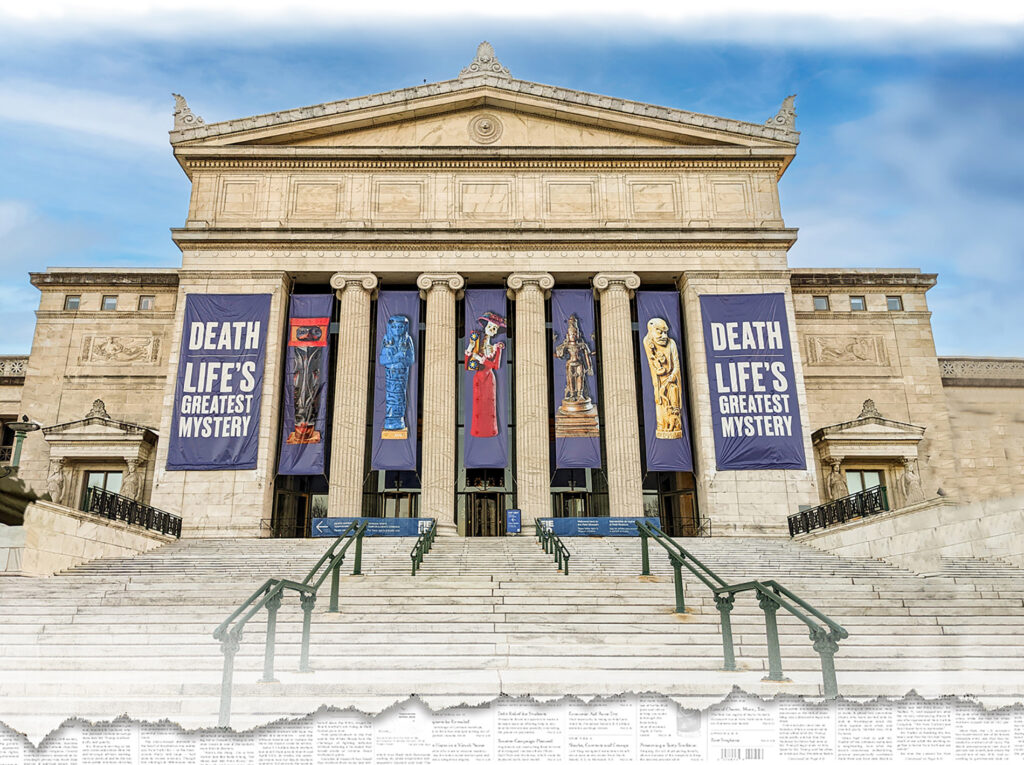
Kate Golembiewski ’12 is living her dream.
Not her childhood dream—that involved living on a farm with a variety of exotic dogs, where she imagined people would pay to pet the dogs and learn facts about them.
“I soon learned that this was not a job,” Golembiewski said with a laugh.
Yet the kernel of that childhood dream—the finding of facts, the sharing of science—would stick with her.
On a cold November day, Golembiewski sits in one of the Field Museum’s research libraries with the Chicago skyline visible out the window, reflecting on her journey. A self-proclaimed geek interested in zoology, thermodynamics and death (“Ms. Frizzle meets Morticia Addams,” her Twitter bio proclaims), Golembiewski is witty, dynamic and self-deprecating, dimpling as she cracks jokes and gesturing animatedly as she enthusiastically talks science. Her nails are painted black, her lipstick is bright red, and a tattoo featuring leaves, flowers, a snail, fungi and an opossum skull spans her upper arm.
Growing up, she was sure she would become a scientist. And yet, she was curious about many other things as well—French, writing, linguistics, literature.
As she approached her college search, “I knew that I had this very cross-cutting series of interests,” Golembiewski said. “With the schools I was looking at, there was pressure to choose between those disciplines.”
Even liberal arts universities would tell her she could double major in chemistry and French, or biology and linguistics—if she was willing to forego study abroad and take five years to graduate.
Then her high school guidance counselor suggested she investigate Kalamazoo College, which he read about in Colleges That Change Lives as a school that encourages a wide range of inquiry, study abroad and academic rigor.
“When I told the admissions counselors at K that I was interested in all these different things, they said, ‘Perfect, great, I can name five people who are doing that exact weird double major combo,’” Golembiewski said. “So right from the get-go, it was clear that K was going to be a place that would let me explore all these diverging academic interests.”
The College’s down-to-earth vibe struck a chord with her, too. The personal attention, hands-on experiences, open curriculum and study abroad opportunity at K eventually sent her down a new career path—one that, in retrospect, Golembiewski was preparing for her whole life.
Her first college chemistry course with Professor of Chemistry Jeff Bartz bolstered her love of science.
“I loved that class,” Golembiewski said. “It reaffirmed everything I knew I was interested in about chemistry. That course in particular is one where you get into intro-level thermodynamics and physical chemistry, which is the area I’m most excited about. Dr. Bartz is so funny and so warm and welcoming. I don’t know that many people who say, ‘I had a terrific time in my big entry-level chem class!’ but it was great.”
Very quickly, however, Golembiewski got into chemistry classes with lab components, where she made an unsettling discovery.
“I hate lab work,” Golembiewski said. “I want to learn about science and talk about science every single day. And also, if I go the whole rest of my life and never have to titrate anything again, it will be a life well lived.”
[Titrating, for the nonscientists, involves continually measuring and adjusting the pH of a solution to achieve the correct balance of acid and base.]
An electrochemistry internship at Loyola University Chicago reinforced that Golembiewski did not want to be a chemist.
“I had an amazing supervisor, we were doing cool stuff, and I loved learning the chemistry,” she said. “When we talked about what we were trying to do, I was so on board. Then when it was, ‘OK, we have to polish these electrodes for 15 minutes and couple them to the cathodes,’ I was like, ‘Please, never again.’”

At the same time as Golembiewski was re-evaluating her plans to be a scientist, her interest in writing was re-emerging.
“I fell in with a real creative writing-y crew at K,” Golembiewski said. “A lot of my friends were creative writing majors, so some peer pressure brought back up this interest that I had on my own but didn’t really pay that much attention to.”
She joined the editorial staff for literary magazine The Cauldron, worked night shifts in the library and “was mostly just hanging out with a bunch of sad writer kids being sad,” she said jokingly.
She spent a pivotal semester abroad in Aberdeen, Scotland, in the fall of her third year.
“It was a dream come true,” Golembiewski said. “I was there with my best friend, and it was just magical, magical, magical. I took a bunch of English and linguistics courses while I was over there, and it cemented for me that I wanted to get more serious with the English stuff I was doing.”

One fateful day in Scotland, Golembiewski needed a signature on a course registration form.
“It was pouring rain,” she said. “Scotland’s always a little bit rainy, just misty, but this was sheets of rain. So, I get to the building where I needed to get something signed, and I’m soaked, and it was in the college’s natural history museum. They’ve got a big baleen whale suspended from the ceiling. I had this little notebook I kept with me, a combination of grocery lists and things I wanted to remember. I remember sketching some of the stuff I saw, and I wrote down, ‘I think I want to work in a museum. I’m so happy when I’m in a museum.’”
That moment of epiphany stuck with her as she returned to Kalamazoo in the spring and took her first class with Professor Emerita of English Gail Griffin on literature of the Romantics.
“I absolutely loved it,” she said. “I fell in love with Gail; I fell in love with the class. That’s the era where you have lots of writers confronting the tension between the natural world and the industrial revolution. There’s a lot with this concept of the sublime, things that are so big and beautiful as to be scary and awful at the same time.”
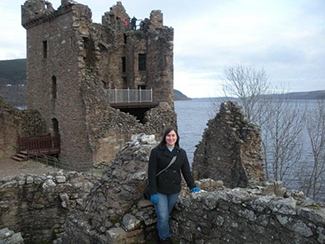
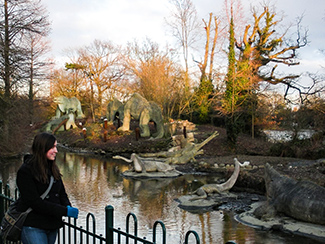
Inspired by that class, she completed an English Senior Integrated Project on The Rime of the Ancient Mariner and Kubla Khan, two poems by Romantic poet Samuel Taylor Coleridge. Her SIP explored ideas about telling stories and the ways in which the telling fails to convey the sublimity of an experience. She also took creative non-fiction and an English literature senior seminar, filling her schedule with courses taught by Griffin as well as Professor Emerita of English Diane Seuss ’78.
“My last year at K was almost like a crash course English major,” Golembiewski said. Along the way, she realized there was a life to be had writing about science.
“Had I had registration in another building in Scotland, who knows where my life would have gone? Had I gone to some big school where you go in the lab once a semester and you pour some stuff and call it a day, maybe I wouldn’t have realized that is not what I wanted to do. God forbid, maybe I would have applied for grad school in chemistry, then realized in a much more high-pressure and expensive situation that I didn’t want to be a chemist. Had I not been encouraged to explore all my interests, maybe I would have become a scientist and thought life is just terrible. I feel very, very fortunate.”

On a Thursday night in the spring of 2012, Golembiewski traveled home to Chicago for a members’ night at the Field Museum, where she spoke with an exhibit developer about internship opportunities. While nothing was available at the time, the Field employee gave Golembiewski her card.
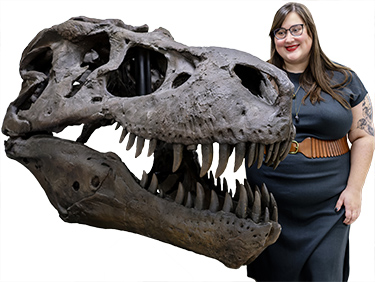
The summer of 2012 was a tough time to find a job, and Golembiewski ended up writing for a company that dealt in online car title loans. Although this was far from her dream job, “I was just excited I had a full-time writing gig,” Golembiewski said.
She reached out to the Field Museum in the fall, and in January 2013, the museum took her on as an intern, which led to a temporary and then a full-time job. She spent a few years as an exhibit developer before moving to the museum’s public relations department. Ten years in at the museum, Golembiewski has earned a master’s degree in science writing from Johns Hopkins University and is currently public relations and science communications manager at the Field.
“The museum is an active research institution,” Golembiewski said. “For everything you see when you come to the museum, less than 1 percent of our holdings are on display. The rest are shelves full of bats, and jars full of snakes, and all kinds of amazing scientific things that are spooky and beautiful, that researchers here and around the world use to try to answer big questions about evolution and climate change and how everything fits together in life.”
When Field scientists publish a paper, discover a species, bring something new into the collection or otherwise do something noteworthy, Golembiewski writes a press release that translates the science for a general audience and works with news outlets to help those stories reach a wider world.
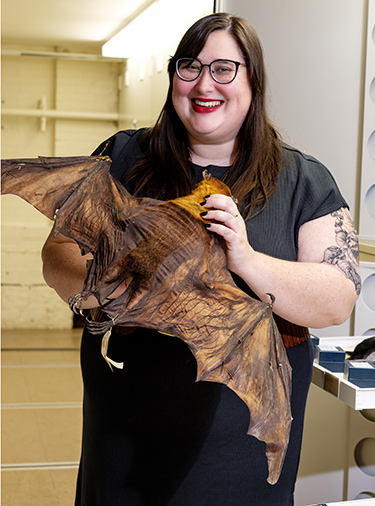
“Any time we have a new scholar come through, I get to learn a whole new thing for a few minutes, days, or weeks, and I love that,” Golembiewski said. “In addition to not enjoying lab work, I also probably would have made a poor scientist because you have to really drill down into one discrete area. By and large, you’re not just like, ‘I study dinosaurs!’ You’re like, ‘I study ornithuromorpha birds just after they diverged in the Early Cretaceous.’ You get very specific and I’m definitely more of a generalist. I love that today we’re talking about meteorites, and tomorrow we’re talking about birds, and the next day we’re going to talk about fungi.”
Working behind the scenes of the museum, in its warren of hallways, stairways and elevators, work rooms and libraries, research equipment, and cupboard after cupboard, drawer upon drawer of collection items, is “amazing,” Golembiewski said.
“When you go to the Field Museum, the front of house is incredible. It’s lovely. I love behind the scenes even more because that’s where all the magic happens. There are all these incredible, weird things that you can get right up close with, and you get to meet the people who know more about that thing than anyone in the world.”
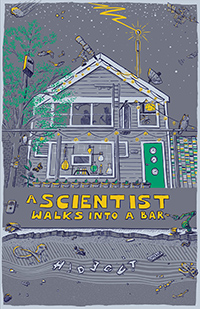
In addition to her work at the Field, Golembiewski engages in science communication through a monthly comedy talk show called A Scientist Walks into a Bar, where she interviews scientists about their work, as well as through free-lance science writing.
She’s written for publications including The Atlantic, National Geographic Voices, and Atlas Obscura on topics as wide-ranging as why sea dragons are so strange, how chewing shaped human evolution, the lost Victorian art of egg collecting, the effects of Earth spinning faster than it was 50 years ago and the science behind Ouija boards.
In 2022, she published her first pieces for CNN (“Mystery Parasites on Zombie Ant Fungus Identified by Scientists”) and Scientific American (“Jewel Beetles’ Iridescent Shells Deter Hungry Birds—By Freaking Them Out”) and received honorable mention in Best American Science and Nature Writing for an article titled “How the Heart Became the Symbol of Love, Lust, and the Soul” in Discover Magazine.
In 2022, she also had her first piece published in The New York Times, about life’s preference for symmetry, and her first front-page New York Times piece about doppelgangers, and realized that science writing was the dream all along.
Publication in The New York Times “was kind of a life goal even before I realized I wanted to be a science writer,” Golembiewski said. “I always really loved reading the science section of the paper and reading books about science, popular stuff. If you look back on it, my entire life, you’d say, ‘Oh yeah, you’re clearly laddering up to be a science writer. This is what you’ve always been training for,’ but no one told me.”
Recently, Discover Magazine commissioned a piece about the trope of the mad scientist, which brought her full circle to her time at K, learning Frankenstein and The Strange Case of Dr. Jekyll and Mr. Hyde with Griffin.
“It all starts with what Gail taught me, and she was one of my interviewees for this article,” Golembiewski said. “It was really, really exciting to get to talk with her again in that context. We’ve stayed in touch over Facebook, just, ‘Look at my cat.’ ‘Look at my cat.’ To be able to have this kind of conversation, it was like we were back in her old office in Humphrey house. It was great.”